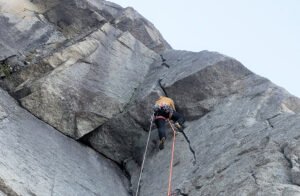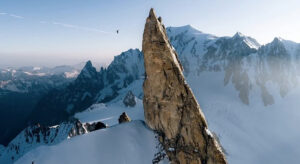While many alpinists have climbed all of the Alps’ 4,000m peaks, just a handful have chained them all together in a single expedition.
Earlier this year, Roeland van Oss became the fourth climber and the first Dutchman to enchain all of the Alps’ highest mountains. This accomplishment includes about 100,000m of total elevation gain.
When he summited the final mountain — Barre de Ecrins on Aug. 12 — van Oss had spent 78 days climbing and biking. He joins the legendary ranks of the only mountaineers to complete this massive solo undertaking: Diego Giovannini, Franco Nicolini, and Ueli Steck.
The Dutch alpinist used no vehicles or cable cars throughout the journey. He wanted to accomplish the feat while remaining carbon-neutral. As a result, he cycled more than 1,300km between the 600km of hiking and climbing.
Van Oss used the expedition to bring attention to climate change, naming his trip the Climbing4Climate project. He leveraged his social media account to tell his story in real-time and encouraged people to make climate pledges.
“As a mountain guide and mountaineer, I see how the Alps are suffering: glaciers are melting, sections of rock are collapsing, seasons are changing, droughts and floods follow one another,” van Oss wrote for Alpine Mag. “We have to do something, and just talking about it won’t work. I think we need actions that inspire, that lead by example.”

Photo: Roeland van Oss
A changed mountain range
While van Oss might have already known that the Alps are changing rapidly, completing this new challenge offered many reminders.
When the two Italian climbers, Giovannini and Nicolini, climbed all the 4,000m peaks, they managed it in 60 days. It took 62 days for Steck to do the same thing solo.
For van Oss, the most significant factor in his increased timetable came from the receding glaciers and crumbling rock that has transformed the Alps. He faced problems from the first peak, Piz Bernina (4,048m). Arriving at the base, he immediately understood why no one had yet climbed it that season. The glacier had dried up, making it “a labyrinth to cross” and shattering van Oss’s early confidence, he wrote.
In his first nine days, van Oss climbed just one peak. He then made up for the lost time by climbing 25 peaks in the following 13 days.
In Chamonix, the Dutchman once again faced dangerous climbing from loose rock. He called conditions “the worst I have ever seen” in that area. The Matterhorn had so little snow and ice that van Oss climbed the entire thing without crampons.
In likely his most challenging day, van Oss climbed seven of the 4,000m peaks in a single push. He made the traverse from Mischabeljoch Biwak over the Taschhorn (4,491m), Dom (4,545m), on to Dirruhorn, and finally, the campsite in Täsch, the UIAA wrote.
Summing up the experience, van Oss wrote that the problems he experienced throughout the challenge reflected how quickly mountains change.
“It sadly demonstrated how important the problem is: it was extremely hot and dry, and many routes were strongly discouraged or unaccompanied of guides due to falling rocks and ice. On the other hand, several major incidents in the mountains could be directly linked to climate change.”






